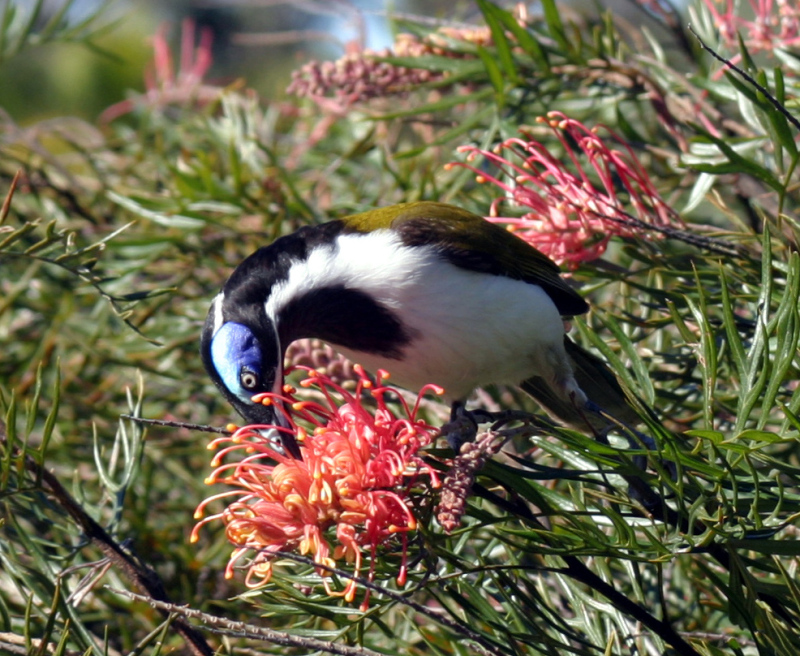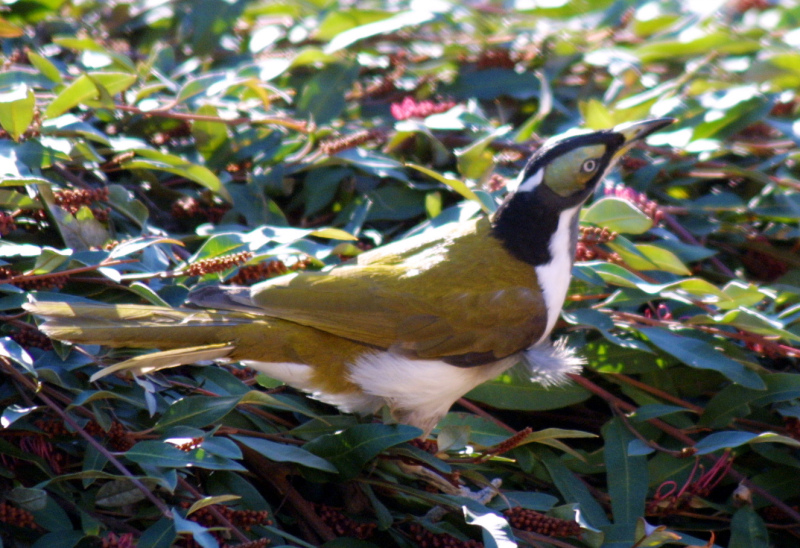Colours
Distinguishing features
It has broad wings with rounded tips and a medium squarish tail. The sturdy slightly downcurved bill is shorter than the skull. It is easily recognised by the bare blue skin around its eyes.
The head and throat are otherwise predominantly blackish with a white stripe around the nape and another from the cheek. The upperparts, including mantle, back and wings, are a golden-olive colour, and the margins of the primary and secondary coverts a darker olive-brown, while the underparts are white.
Juveniles that have just fledged have grey head, chin and central parts of their breasts, and brown upperparts, and otherwise white underparts. After their next moult, they more closely resemble adults and have similar plumage, but are distinguished by their facial patches. The bare facial skin of birds just fledged is yellow, sometimes with a small patch of blue in front of the eyes, while the skin of birds six months and older has usually become more greenish, and turn darker blue beneath the eye, before assuming the adult blue facial patch by around 16 months of age. (Wikipedia)
Size
- From 25 cm to 32 cm (Length of specimen)
Wingspan
- Up to 44 cm
Synonyms
Distribution
Distribution and habitat preferences
They live throughout rainforest, dry sclerophyll (Eucalyptus) forest, open woodland, Pandanus thickets, paperbarks, mangroves, watercourses, and wetter areas of semi-arid regions, as well as parks, gardens, and golf courses in urban areas.
The understory in eucalypt-dominated woodland where the Blue -faced Honeyeater is found is most commonly composed of grasses such as Triodia, but sometimes it is made up of shrubs or small trees such as grevilleas, paperbarks, wattles, Cooktown ironwood (Erythrophleum chlorostachys) or billygoat plum (Terminalia ferdinandiana). (Wikipedia)
Diet
The bulk of their diet consists of insects, including cockroaches, termites, grasshoppers, bugs such as lerps, scale (Coccidae) and shield bugs (Pentatomidae), beetles such as bark beetles, chafers (subfamily Melolonthinae), click beetles (genus Xanthophaea), darkling beetles (genera Chalcopteroides and Homotrysis), leaf beetles (genus Paropsis), ladybirds of the genus Scymnus, weevils such as the pinhole borer (Platypus australis), and members of the genera Mandalotus, Polyphrades and Prypnus, as well as flies, moths, bees, ants and spiders. Birds have been reported preying on small lizards. Prey are caught mostly by sallying, although birds also probe and glean.
The remainder of their diet is made up of plant material such as pollen, berries, nectar, from such species as grasstrees (Xanthorrhoea) and scarlet gum (Eucalyptus phoenicea), and cultivated crops such as bananas and grapes. In general, birds prefer feeding at cup-shaped sources such as flowers of the Darwin woollybutt (Eucalyptus miniata), Darwin stringybark (E. tetrodonta) and long-fruited bloodwood (Corymbia polycarpa), followed by brush-shaped inflorescences, such as banksias or melaleucas, gullet-shaped inflorescences such as grevilleas, with others less often picked. (Wikipedia)









